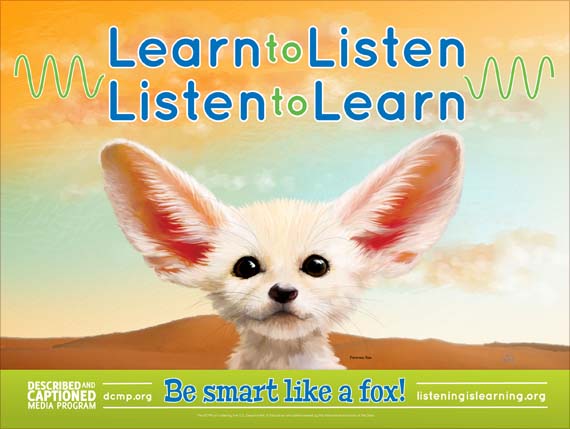<< Learning Center
Media Accessibility Information, Guidelines and Research

Lesson Guide
Section l: The Fennec Fox
Section 2: Listening
Section 3: Description

The Fennec Fox
Background
A fun activity for younger children centers on the fennec fox. You can order your fennec fox poster (pictured above), certificates of participation, a fennec fox mask, and other materials from the DCMP.
The fennec fox, sometimes called the desert fox, is found in the African Sahara Desert. Its name comes from the Arabic word fanak, which means fox. It is dust colored, helping it blend into the desert.
The fennec fox is well known for its large ears, which can be half as long as its body. It has extraordinary hearing, sensitive enough to hear prey moving underground. But its ears also keep it cool by regulating body heat.
The fennec fox is the smallest fox in the world, growing to about 1 ½ feet high and weighing an average of 3 pounds. It has a remarkably long tail, which ranges in length from 7 to 12 inches. It also has a thick fur coat.
Learn more about the desert fox by visiting:
A-Z Animals
National Geographic
Activities
- It is interesting to compare the big ears of the fennec fox with the small ears of the artic fox. Artic foxes live in cold climates and do not need to shed heat. What would happen if the artic fox had big ears? Use this opportunity to contrast the climate and geography of deserts and the artic.
- It is also interesting to think about the hair of the fennec fox. Why would a fox that lives in the desert need a thick fur coat? (Answer: Desert nights can be cold.) How would the fennec fox’s long tail help it at night?
- The fennec fox is nocturnal and an omnivore. Define those terms and compare/contrast these traits in other animals. Also, define the terms camouflage and predator. Explain that the fennec fox color helps it evade wild cats, jackals, owls, and hyenas.
- A group of foxes can be called a “skulk,” “leash,” “troop,” or “earth.” If you are going to award a Fennec Fox Certificate to your students, point out that you will sign the award as the “Troop Leader.” Ask if students know the following collective nouns, and add your own to the list.
- a herd of cattle
- a pride of lions
- a murder of crows
- a crash of rhinos
- a congress of baboons
- Foxes are known for being very intelligent—enough to elude pursuers. Can your students name other intelligent animals and how they demonstrate their intelligence? Foxes are also described as being crafty, cat-like, cunning, determined, focused, quick, quiet, shy, stealthy, tricky, and wise. What do these terms mean? Do any other animals share these characteristics?
- Using a fox theme for a lesson plan series gives you the chance to teach several different subject areas. The fox lesson plan theme can incorporate life sciences, ecology, social studies, and language arts. It can also include time to discuss the role of humans in protecting wildlife. A fennec fox lesson plan can incorporate a study of North Africa and Saudi Arabia geography. A perfect conclusion to a unit would be a fieldtrip to a zoo or wildlife center to see a fennec fox.
- Incorporate activities from the “Listening” and “Video Description” sections of this guide. Donning the fennec fox mask, your sighted students will experience the world the same way a blind person experiences it.
Listening
Background
While most people hear, they do not always listen. The two terms, listening and hearing, are often used interchangeably but mean very different things. According to the International Listening Association: 1) 45 percent of a student’s day is spent listening; 2) Students are expected to acquire 85 percent of their new knowledge through listening, and; 3) Only 2 percent of the population ever received formal listening instruction.
It is difficult for those of us who hear to think of many tasks that do not seem to require hearing, but many people do not hear or do not hear well. The DCMP serves deaf and hard of hearing children, including those with cochlear implants who also need training in listening.
Teachers and parents should recognize that listening has to be learned. This is of obvious importance to auditory learners, for whom listening is learning. Not to mention that good listeners follow directions, understand expectations, are better motivated, communicate more clearly, and have higher academic performance. But while we teach children to talk and adults to speak in public, we don't teach listening. It's hardly surprising that many children are not very good at it.
Activities
- Learning Ally provides wonderful information and links to activities at Learning Through Listening. Follow their tips for Ten Steps to Effective Listening, How Can I Teach Listening?, Listening Skills Inventory, and much more.
- The American Speech-Language Hearing Association (ASHA) provides links to listening activities which are great with all children and “...are also used to help individuals recovering from aphasia to improve auditory memory, teach individuals with autism spectrum disorders, help clients with attention or central processing disorders, and serve many other clients.” The following resources are samplings of resources ASHA provides.
- The FindSounds search engine locates sounds made by birds, animals, natural events, household items, musical instruments, holiday events, people, tools, vehicles, and more.
- Bananas in Pyjamas offers a timed animal/sound matching and concentration activity with easy, hard, or very hard examples.
- Animal Sounds invites the user to listen to an animal and then type the name of the animal from a word bank of 21.
- Who Am I? asks users to identify the sound made at night by 20 animals.
- Alien Scavenger Hunt asks players to choose the sounds they hear in the word presented.
- Memory is a concentration game of sounds and words.
- Fuzzy Lion Ears is a game of listening for beginning sounds in words.
- Listening Games from English Language Listening Lab Online provides several audio examples and asks the listener to choose the correct picture of the source and answer a question.
- Audio concentration games are timed and very challenging.
- Paths to Literacy states that while many children who are blind or visually impaired are able to repeat what they hear, repeating a sound is not the same as understanding it. You can help your child or student to develop this skill by asking questions to encourage the digesting of information and to think about what was heard. This activity need not be limited to formal classroom lessons, but can be when you are reading a story, watching TV, or having a conversation. Additional tips and activities are provided on the website.
- The Texas School for the Blind and Visually Impaired indicates that children who are deaf-blind need to learn to use whatever residual hearing they may have, for a variety of reasons including travel safety, identifying people, literacy, and communication. Auditory skills development, just like visual skills development, requires well-thought-out instruction that is provided regularly and consistently throughout the children’s school career. Additional tips and activities are provided on the website.
Description
Background
Description is the verbal depiction of key visual elements in media and live productions. Also known as “audio description” or “video description,” the description of media involves the interspersion of these depictions with the program’s original audio.
As far back as 1964, advocates for accessibility envisioned the type of equal access that description could provide to people who are blind or visually impaired. Description also has roots in radio reading services for the blind, which began in Minnesota in 1969. In 1981 the radio reading service of Washington, D.C. is credited with the invention of the first ongoing audio description service. In the late 1980s, description service was introduced to television audiences and in 1997 to movie theatres. (For more on the history of description, read DCMP’s Description Timeline Highlights [PDF].
Description services are now routinely offered by several providers at movies, museums, and dance productions, as well as on television, to viewers with visual impairments. Known by several terms—“audio description,” “video description,” “descriptive video information,” “Descriptive Video Service™” and "DVS™," “narrative description,” and/or “descriptive video”—description is typically provided through a secondary audio channel or the Secondary Audio Programming (SAP) channel for analog television and ancillary audio services for DTV.
For sighted children, description offers a promise of a new way to promote literacy and learning. This is consistent with the pattern that repeats itself throughout the history of technological development; innovations and accommodations made for people with disabilities benefit many people without disabilities. Even Alexander Graham Bell's invention of the telephone grew out of his efforts to assist people with hearing disabilities.
Activities
- Ask students to imagine that while they are watching TV the picture suddenly disappears. Would they be able to understand what was happening during the program? Explain that this is how persons who are blind experience television and the movies, but they still “watch” TV with their families, friends, and in school. If you have a visually impaired student in class, have him or her share personal “viewing” experiences with the class.
- Order fennec fox masks from the DCMP. Have your students put on a mask to experience a video clip or television program the same as a visually impaired person experiences it.
- Discuss (or draw pictures of) what the students “saw” in their minds’ eye.
- Have students identify new words they never heard before (if any). Define these words, and ask the students to use them in a sentence or in a “story.”
- Watch the same video without the mask, with students discussing how accurate they were in guessing the visual content.
- View a video with description. Your resource for such a video is the DCMP if you have a blind or visually impaired child in your class. But anyone can watch online described videos at Narrative Television Network and Movies for the Blind. Also, a select number of movie theaters in the U.S. offer showings with description, or you can purchase a described movie on DVD. Finally, DCMP has video clips on its YouTube channel.
- First, view the video with the description turned off (if possible). Explain that some programs add special narration to videos to describe the visuals for blind people. Tell the students that they will “watch” the first few minutes of the video while wearing a fennec fox mask or blindfold. They will try to determine what is happening based only on what they hear, without the description. Then they will write down what they think happened. Some students can read this aloud.
- Second, view the video with the description turned on, with students again wearing a mask. Ask the students if the description effectively explained the visual content.
- Watch another video with students, viewing it in segments. During silent portions of the video, have students write description that might be inserted to help blind and visually impaired persons understand. Tell them their goal is to “make the visual verbal.” What are the most critical visual components to describe for blind viewers? When would things like colors or emotions be important to describe?
- Utilize the DCMP Learning-Focused activity and incorporate fun activities centered on the fennec fox, listening, and description.

